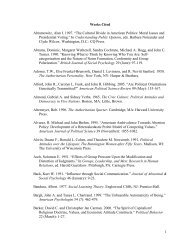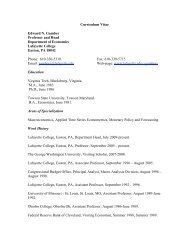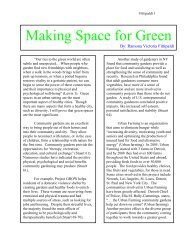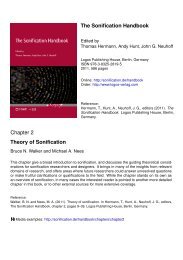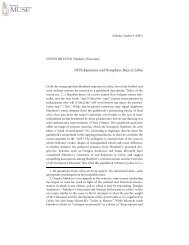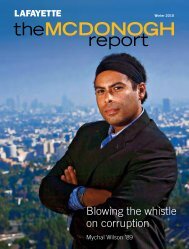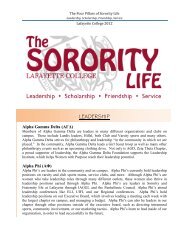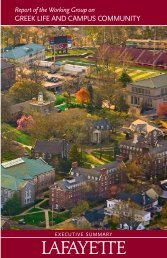2007 - Sites at Lafayette - Lafayette College
2007 - Sites at Lafayette - Lafayette College
2007 - Sites at Lafayette - Lafayette College
You also want an ePaper? Increase the reach of your titles
YUMPU automatically turns print PDFs into web optimized ePapers that Google loves.
Winter <strong>2007</strong><br />
theMcDonogh<br />
report<br />
EPI: At the Forefront of African<br />
American Art and Culture
Message From the President<br />
theMcDonogh<br />
report<br />
{fe<strong>at</strong>ure<br />
EPI’s Cre<strong>at</strong>ivity and Achievement .....4<br />
Experimental Printmaking Institute<br />
celebr<strong>at</strong>es a decade in the forefront of<br />
African American art and culture<br />
{profiles<br />
Constant Struggle ................8<br />
Gerald Gill ’70, a force for change as an<br />
undergradu<strong>at</strong>e <strong>at</strong> <strong>Lafayette</strong>, is an awardwinning<br />
professor <strong>at</strong> Tufts University<br />
I am delighted to welcome you as readers of The McDonogh<br />
Report, a new public<strong>at</strong>ion th<strong>at</strong> celebr<strong>at</strong>es the impressive contributions of<br />
African Americans to the <strong>Lafayette</strong> <strong>College</strong> community.<br />
As you read this inaugural issue, I hope you will feel a special measure<br />
of pride in the alumni who are profiled, including David K. McDonogh,<br />
M.D., Class of 1844, and Gerald R. Gill, Ph.D., Class of 1970. You will also<br />
be impressed by the insights of our 2006 Pepper Prize winner, Nangula<br />
Shejavali, and the remarkable success of Prof. Curlee Raven Holton and the<br />
Experimental Printmaking Institute.<br />
In convers<strong>at</strong>ions with a number of our African American students, alumni,<br />
faculty, and staff, I have developed a special appreci<strong>at</strong>ion for the contributions<br />
of African Americans to our academic community. I have valued their positive<br />
comments about the things we are doing well and have benefited from their<br />
candor in challenging us to do better. I would especially like to thank my<br />
colleagues, Trustee Riley Temple ’71 and Professor Curlee Holton for their<br />
vision and assistance in helping to bring this public<strong>at</strong>ion to fruition.<br />
I hope you will find th<strong>at</strong> this public<strong>at</strong>ion reflects the unique<br />
contributions of African Americans to our college. I am especially excited<br />
about the Report, however, because it is not just about past and present<br />
achievements. It is also about aspir<strong>at</strong>ions. In addition to sharing the good<br />
news of the accomplishments of the African American members of our<br />
community, future issues will also provide an opportunity for you to voice<br />
your hopes and dreams for <strong>Lafayette</strong>.<br />
The <strong>College</strong> and I welcome your ideas—and your involvement.<br />
Daniel H. Weiss<br />
“In convers<strong>at</strong>ions with a number of our<br />
African American students, alumni, faculty,<br />
and staff . . . I have developed a special<br />
appreci<strong>at</strong>ion for your contributions to the<br />
{diversity th<strong>at</strong> is so important to the <strong>College</strong>.”<br />
Weaver Family Legacy ........... 10<br />
George ’72, Sylvia ’75, Stephanie ’03,<br />
and Danielle ’07 are a multigener<strong>at</strong>ional<br />
<strong>Lafayette</strong> family<br />
Leadership, Service, Success ...... 12<br />
Jeffrey Robinson ’80 is one of the<br />
most prominent <strong>at</strong>torneys in the<br />
N<strong>at</strong>ion’s Capital<br />
{young alumni<br />
Gre<strong>at</strong> Wisdom and Good Hunting .....3<br />
Nangula Shejavali ’06 is the first woman<br />
of African descent to win the Pepper Prize<br />
Unique Fusion ................ 14<br />
Maya Freelon ’05 is a rising star<br />
Amazing Impact ............... 19<br />
Molefi K. Asante Jr. ’04 earns intern<strong>at</strong>ional<br />
renown for his films, poems, and essays<br />
{news<br />
Adding His Voice............... 15<br />
Ross Gay ’96 publishes Against Which,<br />
his first volume of poetry<br />
Campus Connections ............16<br />
John Hope Franklin, Angela Davis,<br />
William T. Williams, Aaron O. Hoff, more<br />
Remembering McDonogh 1844 .... 20<br />
Campus sculpture will commemor<strong>at</strong>e the<br />
granting of a degree to David McDonogh,<br />
a slave<br />
The McDonogh Report | Winter <strong>2007</strong><br />
Editor: Roger Clow<br />
Designer: Dale Mack<br />
www.lafayette.edu
Ascending<br />
Gre<strong>at</strong> Wisdom and Good Hunting<br />
Nangula Shejavali ’06<br />
“If we were all asked to independently define ‘the<br />
<strong>Lafayette</strong> Ideal,’ there is no doubt th<strong>at</strong> each definition would<br />
differ from the next—a concept th<strong>at</strong> illustr<strong>at</strong>es our diversity<br />
in thought, background, need, represent<strong>at</strong>ion, and priority,”<br />
said Pepper Prize winner Nangula Shejavali ’06 when she<br />
was nomin<strong>at</strong>ed as one of 10 finalists for the award.<br />
The first woman of African descent to receive the Pepper<br />
Prize, Shejavali said, “I believe th<strong>at</strong> a student who challenges<br />
complacency and strives to ‘be the change they wish to see<br />
in the world,’ as Gandhi said, embodies this ‘ideal.’”<br />
She was indeed active in cre<strong>at</strong>ing positive change during<br />
her four years on campus. The founder and chairperson of<br />
the student organiz<strong>at</strong>ion ACACIA (Africans Cre<strong>at</strong>ing African<br />
Consciousness and Interest Abroad), Shejavali, of Windhoek,<br />
Namibia, was the prime mover in organizing two major<br />
conferences on the present and future of Africa. She was also<br />
president of the Intern<strong>at</strong>ional Students Associ<strong>at</strong>ion and a<br />
leader or member of the Associ<strong>at</strong>ion of Black Collegians, NIA,<br />
<strong>Lafayette</strong> African and Caribbean Students Associ<strong>at</strong>ion, and<br />
Hispanic Society of <strong>Lafayette</strong>, among others.<br />
“There is an African proverb th<strong>at</strong> st<strong>at</strong>es, ‘When a needle<br />
falls into a deep well, many people will look into the well,<br />
but few will be ready to go down after it,’ Shejavali said.<br />
“There have been many such needles both on and off the<br />
<strong>Lafayette</strong> campus, represented by issues such as diversity,<br />
social justice, cross-cultural dialogue, intern<strong>at</strong>ional<br />
understanding, and discourse on Africa. It is within the<br />
realm of these issues th<strong>at</strong> I have personally striven to enact<br />
change <strong>at</strong> <strong>Lafayette</strong>.”<br />
She was honored with the David A. Portlock Cross-<br />
Cultural Rel<strong>at</strong>ionship Award, given annually to a<br />
student for working diligently to promote cross-cultural<br />
rel<strong>at</strong>ionships on campus, and/or the community, and The<br />
People’s Choice Award, given to students or employees<br />
known as unusually productive and concerned for the<br />
betterment of the college and its student body.<br />
Shejavali also served as head resident adviser and a<br />
member of the presidential inaugur<strong>at</strong>ion committee and<br />
search committees for the provost, director of religious life,<br />
and others. She gradu<strong>at</strong>ed magna cum laude with majors in<br />
intern<strong>at</strong>ional affairs and Africana studies and was elected<br />
to Phi Beta Kappa. In her honors thesis in Africana studies<br />
she analyzed the efficacy and sustainability of healthcare<br />
systems for HIV/AIDS orphans and vulnerable children in<br />
Namibia.<br />
Speaking <strong>at</strong> the 171st Commencement in May, Shejavali<br />
cited another African proverb: Hunt in every forest, for there<br />
is wisdom and good hunting in all of them.<br />
“Looking back on your<br />
own experience, how<br />
have you diversified your<br />
hunt?” she asked her<br />
classm<strong>at</strong>es. “Have you<br />
sought knowledge only<br />
from those people and<br />
places th<strong>at</strong> looked most<br />
appealing or did you<br />
broaden th<strong>at</strong> experience<br />
to include people of<br />
different backgrounds,<br />
economic st<strong>at</strong>uses, job<br />
titles, races, religions, sexual<br />
preferences, and ethnicities?<br />
In the planning of a Dance<br />
Mar<strong>at</strong>hon, the setting up of an<br />
Extravaganza show, the winning of a football game, or your<br />
day-to-day experiences in the residence halls, how many<br />
times did you take the opportunity to cre<strong>at</strong>e friendships<br />
with the custodians, grounds staff, secretaries? Did you limit<br />
your friendship circle to include only those th<strong>at</strong> look, think,<br />
speak and act like you or did you embrace diversity in all its<br />
forms to enrich your <strong>Lafayette</strong> Experience?<br />
“Today I am challenging you to remove yourself from your<br />
comfort zone, and hunt in those forests th<strong>at</strong> may not look so<br />
appealing, but from which gre<strong>at</strong> wisdom and good hunting<br />
can be found.” n
Experimental Printmaking<br />
Institute Celebr<strong>at</strong>es<br />
10 Years of Cre<strong>at</strong>ivity,<br />
Achievement<br />
A year-long 10th anniversary celebr<strong>at</strong>ion fe<strong>at</strong>ures<br />
special events and exhibits showcasing a decade of<br />
remarkable work and reflecting EPI’s st<strong>at</strong>ure in the forefront of<br />
African American art and culture n<strong>at</strong>ionally and intern<strong>at</strong>ionally.
Since its founding in 1996 by Curlee Raven Holton,<br />
professor and head of art, EPI has provided an open and cre<strong>at</strong>ive<br />
environment for professional artists and students to cre<strong>at</strong>e<br />
new bodies of work while investig<strong>at</strong>ing and experimenting<br />
with a wide variety of approaches to the print medium.<br />
“EPI is the only workshop of its kind in a four-year liberal<br />
arts institution in the United St<strong>at</strong>es th<strong>at</strong> brings renowned<br />
artists and students together to experiment with the printmaking<br />
medium in a research and educ<strong>at</strong>ional labor<strong>at</strong>ory<br />
setting,” Holton says. “We want to make printmaking a<br />
prominent visual arts language and give it value as a cre<strong>at</strong>ive<br />
means of expression. This fits with <strong>Lafayette</strong>’s mission<br />
of excellence, cre<strong>at</strong>ivity, and achievement.”<br />
EPI’s exhibitions and intern<strong>at</strong>ional exchanges have introduced<br />
a broad range of artists and contemporary printmaking<br />
trends to members of the <strong>Lafayette</strong> community and<br />
beyond. Its artist-in-residence and visiting artist programs<br />
have brought more than 70 professional artists from diverse<br />
cultural and social backgrounds to campus, many with<br />
intern<strong>at</strong>ional reput<strong>at</strong>ions, introducing <strong>Lafayette</strong> students to<br />
talented, well-educ<strong>at</strong>ed, and ambitious role models.<br />
“The printmaking studio has provided many students<br />
with the chance to excel in art, to work side by side with<br />
significant artists, and to exhibit their work locally and<br />
n<strong>at</strong>ionally,” Holton says. “This unique experience cannot be<br />
m<strong>at</strong>ched elsewhere, even <strong>at</strong> specialized art schools, because<br />
of the combin<strong>at</strong>ion of <strong>Lafayette</strong>’s resources and the cre<strong>at</strong>ive<br />
vision of EPI.”<br />
Many of the world-renowned artists who have worked with<br />
students, faculty, and local artists <strong>at</strong> EPI have been brought<br />
to the institute through the Temple Performing and Visual<br />
Arts Residency. These include David C. Driskell, Sam Gilliam,<br />
Emma Amos, Barbara Bullock, Roy Crosse, Melvin Edwards,<br />
Robin Holder, Maritza Mosquera, Lou Stovall, Gregory<br />
Warmack (“Mr. Imagin<strong>at</strong>ion”), and William T. Williams.<br />
Among the many other visiting artists and printmakers<br />
are Benny Andrews, Richard Anuszkiewicz, Stephen<br />
Antonakos, K<strong>at</strong>ie Amelia Baldwin, Robert Beckman,<br />
Berrisford Boothe ’83, Duncan Bullen, Elizabeth C<strong>at</strong>lett,<br />
Gregory Co<strong>at</strong>es, Alfonso Corpus, Allan Rohan Crite, Wayne<br />
Crothers, Dexter Davis, John E. Dowell Jr., Allan Edmunds,<br />
{<br />
Curlee Raven Holton<br />
An intern<strong>at</strong>ionally known<br />
printmaker and artist, Curlee<br />
Raven Holton has mounted<br />
more than 30 one-person<br />
shows and particip<strong>at</strong>ed in<br />
more than 75 group<br />
exhibitions, including shows<br />
<strong>at</strong> the Whitney Museum<br />
of American Art, Seventh<br />
Intern<strong>at</strong>ional Biennale in<br />
Cairo, Centro de Cultura<br />
Casa Lamm Gallery in<br />
Mexico City, and Osaka and<br />
Tokyo, Japan. His works<br />
are in the collection of the<br />
Library of Congress and<br />
those of many museums, universities, found<strong>at</strong>ions,<br />
and corpor<strong>at</strong>ions, including Pennsylvania Academy of<br />
the Fine Arts, Cleveland Museum of Art, West Virginia<br />
Governor’s Mansion, Morehouse <strong>College</strong>, and Fundación<br />
Cultural Rodolfo Morales in Oaxaca, Mexico.<br />
Wanda Ewing, Livma Zarcarias Farah, Grace Hartigan,<br />
Joseph Holston, Shellie Jacobson, Lois Mailou Jones, Kofi<br />
Kayiga, Paul Keene, Bodo Korsig, Hughie Lee-Smith, Lynn<br />
Linnemeier, Al Loving, Ulysses Marshall, Craig M<strong>at</strong>tis, Juan<br />
Alcázar Mendez, Mary Ann Miller, Liz Mitchell, Quentin<br />
Mosely, Karima Muyaes, Carlton Parker, Emilio Payan, John<br />
Phillips, Maryann Riker, Rolando Rojas, James Rose Jr., Faith<br />
Ringgold, Jean Paul Russell, Charles Sallee, Ian Short, Kay<br />
WalkingStick, and Joyce Wellman.<br />
EPI’s distinguished board of advisers, which includes<br />
Gilliam, Ringgold, Edwards, Anuszkiewicz, and Antonakos,<br />
reflects its st<strong>at</strong>ure in African American arts. Also on the<br />
board are William Busta, cur<strong>at</strong>or of collections and exhibitions<br />
<strong>at</strong> Cleveland Artists Found<strong>at</strong>ion; Robert S. M<strong>at</strong>tison,<br />
<strong>Lafayette</strong>’s Metzgar Professor of Art; Lewis Tanner Moore,<br />
African art enthusiast and collector; and Robert E. Steele,<br />
executive director of the David C. Driskell Center for the<br />
“In seeing the work of one of Curlee’s students, I could see the<br />
exchange of energy and the purposeful transform<strong>at</strong>ion after she<br />
had studied with him. Curlee loves the potential in every artist to<br />
be a printmaker. He believes th<strong>at</strong> art is in the individual.”<br />
—Sam Gilliam<br />
www.lafayette.edu/mcdonoghreport January <strong>2007</strong> | theMcDonoghreport | 5
Study of the Visual Arts and Culture of African Americans<br />
and the African Diaspora <strong>at</strong> the University of Maryland.<br />
Its central role in the annual N<strong>at</strong>ional Black Arts Festival<br />
also reflects EPI’s prominence. In addition to mounting<br />
exhibits <strong>at</strong> Atlanta’s High Museum during the festival, EPI<br />
produced the Collectors’ Guild print in each of the last<br />
three years, including Ringgold’s “Wynton’s Tune” in 2004,<br />
Gilliam’s “Wind” in 2005, and Holder’s “They Damaged Us<br />
More Than K<strong>at</strong>rina” last year.<br />
EPI also produces releases in a series of prints cre<strong>at</strong>ed by<br />
prominent African American artists for the Driskell Center,<br />
including Ringgold’s “Mama Can Sing” and Holston’s “Man<br />
in Bo<strong>at</strong>.”<br />
In all EPI has produced more than 100 limited-edition<br />
prints, including 13 for Ringgold, nine for Driskell, and six<br />
Temple Residency<br />
Brings Top Artists<br />
David C. Driskell and Sam Gilliam are among the worldrenowned<br />
artists brought to EPI through the Temple<br />
Arts Residency, supported by the David L. Temple Sr.<br />
and Helen J. Temple Visiting Lecture Series Fund.<br />
David C. Driskell<br />
<strong>Lafayette</strong> fe<strong>at</strong>ured Driskell’s works last winter in exhibits,<br />
jointly titled Reflections and Memories, th<strong>at</strong> included<br />
four prints produced <strong>at</strong> EPI. A leading authority on<br />
African American art and culture, he is an artist, art<br />
historian, cur<strong>at</strong>or, and collector whose paintings, prints,<br />
and collages often reflect his complex experiences<br />
dealing with race. The University of Maryland’s David<br />
C. Driskell Center for the Study of the Visual Arts and<br />
Culture of African Americans and the African Diaspora<br />
brings together visual arts and diasporic studies and<br />
fosters future artists and scholars of color.<br />
Sam Gilliam<br />
Acclaimed as the leading African American artist today<br />
and one of the two most important African American<br />
artists of the last century, Gilliam collabor<strong>at</strong>ed with<br />
Australian master printmaker Wayne Crothers to cre<strong>at</strong>e<br />
a work of art in EPI’s Master Artist/Master Printmaker<br />
Portfolio. EPI produced Gilliam’s print “Wind,” the<br />
N<strong>at</strong>ional Black Arts Festival’s Collectors’ Guild print<br />
for 2005. Gilliam was Grossman Artist-in-Residence<br />
in 2001, and a show of his works was the inaugural<br />
exhibit in the Grossman Gallery in the Williams Visual<br />
Arts Building.<br />
Students, faculty, and local children joined visiting artists<br />
from Mexico and the Lehigh Valley to cre<strong>at</strong>e the longest<br />
print ever made. “We are all a part of history,” says<br />
Curlee Holton. “However, only a few of us ever have an<br />
opportunity to make history.”<br />
for Gilliam. Indeed the printer of choice for world-class artists,<br />
the institute is now producing a c<strong>at</strong>alogue raisonné th<strong>at</strong><br />
will include all works produced on site.<br />
EPI is also viewed more and more as a provider for major<br />
collections, Holton notes. Works produced <strong>at</strong> EPI have been<br />
acquired by the Metropolitan Museum of Art, High Museum,<br />
Yale University, New York University, and Mount Holyoke<br />
<strong>College</strong>. “Students have been involved in producing all the<br />
prints in these prestigious collections,” he adds.<br />
EPI plans a printmaking symposium for March 6-8. The future<br />
will also include collabor<strong>at</strong>ions with the Venice Printmaking<br />
Workshop in Italy and the Traklhaus Workshop in Salzburg.<br />
Events marking EPI’s anniversary began in April with the<br />
cre<strong>at</strong>ion, on campus, of the world’s longest print. Holton<br />
conceived the idea for the mega-print while w<strong>at</strong>ching the<br />
cre<strong>at</strong>ion of a nearly 200-foot-long print in Mexico City. Using<br />
landscaping rollers, artists and volunteers produced a 2,000-<br />
foot-long print, nearly 1,800 feet longer than the previous<br />
record of 200 feet set in 2002 near Philadelphia’s Broad<br />
Street. Instrumental in the effort were Karima Muyaes,<br />
Emilio Payan, and Livma Zarcarias Farah, visiting artists<br />
from Mexico.<br />
Exhibits this fall included More Than a Book (<strong>at</strong> Universidad<br />
Autonoma Metropolitana in Mexico City), Master Artist/Master<br />
Printmaker Portfolio (<strong>at</strong> the Williams Center), Books <strong>at</strong> the EPI-<br />
Center, artists’ books produced <strong>at</strong> the institute (<strong>at</strong> Skillman<br />
Library), Innov<strong>at</strong>ion and Cre<strong>at</strong>ivity in Printmaking (<strong>at</strong> the<br />
6 | theMcDonoghreport | January <strong>2007</strong> www.lafayette.edu/mcdonoghreport
EPI Honorees<br />
EPI honored supporters <strong>at</strong> a special 10th<br />
birthday celebr<strong>at</strong>ion Sept. 8. Among them were<br />
Riley K. Temple ’71, for the Temple Performing<br />
and Visual Arts Residency; artist and author<br />
Faith Ringgold, for her support of the arts<br />
residency; and Diane Windham Shaw, special<br />
collections librarian and <strong>College</strong> archivist, for<br />
Skillman Library’s Book Arts Program.<br />
The institute also honored Mr. and Mrs.<br />
Harold Tague P’00 and Christopher Tague ’00,<br />
for establishing the EPI Residency Fund, and<br />
Dr. and Mrs. Robert Steele, for providing a<br />
new printmaking resource library and setting<br />
up an internship program for <strong>Lafayette</strong><br />
students <strong>at</strong> the University of Maryland’s David<br />
C. Driskell Center for the Study of the Visual<br />
Arts and Culture of African Americans and the<br />
African Diaspora.<br />
Artist and author Faith Ringgold and Riley Temple ’71 were among<br />
those honored <strong>at</strong> the Experimental Printmaking Institute’s 10th<br />
birthday celebr<strong>at</strong>ion<br />
The Experimental Printmaking Institute’s anniversary celebr<strong>at</strong>ion included<br />
an exhibit of works by EPI director Curlee Raven Holton (right) and Alberto<br />
Murillo-Herrera <strong>at</strong> the Portlock Black Cultural Center.<br />
Allentown Art Museum), and Two Masters, works by Holton<br />
and Costa Rican master printmaker Alberto Murillo-Herrera<br />
(<strong>at</strong> the David A. Portlock Black Cultural Center).<br />
More Than a Book, fe<strong>at</strong>uring artists’ books, opened in<br />
Mexico City following a showing <strong>at</strong> the Costa Rican-North<br />
American Cultural Center. Building on previous collabor<strong>at</strong>ions<br />
between EPI and Costa Rican artists, it includes<br />
handmade artists’ books and prints by Holton and other<br />
artists from <strong>Lafayette</strong>, Costa Rica, Mexico City, and the<br />
University of Manchester in England. <strong>Lafayette</strong> students<br />
were involved in all aspects of the exhibition, which<br />
includes works by Carolyn Burns ’09, Caitlin Chandler<br />
’06, Alexis Gale ’05, Ellen Rose ’09,<br />
and Melissa Spitz ’06. The student<br />
cur<strong>at</strong>or is Sara Smith K<strong>at</strong>z ’07. The<br />
exhibit will move to the University<br />
of Manchester.<br />
Master Artist/Master Printmaker includes<br />
16 new works cre<strong>at</strong>ed <strong>at</strong> EPI during<br />
an innov<strong>at</strong>ive two-year project th<strong>at</strong><br />
paired eight master artists with eight<br />
master printmakers. The artists were<br />
Amos, Driskell, Gilliam, Anuszkiewicz,<br />
Hartigan, Korsig, Ringgold, and<br />
WalkingStick. Printmakers—from<br />
workshops in Pennsylvania, Maryland,<br />
England, and Japan—were Phillips,<br />
Beckman and Short, Holton, Crothers,<br />
Russell, Mosely, Dowell, and Edmunds.<br />
Maya Freelon ’05, Zoe Gavriilidis ’05,<br />
Nicole Kozyra ‘05, Chris Metzger ’03,<br />
Chandler and Spitz were all involved in<br />
the project.<br />
Innov<strong>at</strong>ion and Cre<strong>at</strong>ivity showcases<br />
works produced <strong>at</strong> EPI in collabor<strong>at</strong>ion<br />
with Anuszkiewicz, Driskell,<br />
Gilliam, Hartigan, Ringgold, C<strong>at</strong>lett,<br />
Crite, Jones, and others. n<br />
www.lafayette.edu/mcdonoghreport January <strong>2007</strong> | theMcDonoghreport | 7
Among many scholarly<br />
pursuits, Gerald Gill ’70,<br />
associ<strong>at</strong>e professor of<br />
history <strong>at</strong> Tufts University,<br />
has conducted extensive,<br />
groundbreaking explor<strong>at</strong>ions<br />
of the history of African-<br />
Americans <strong>at</strong> Tufts and of<br />
race rel<strong>at</strong>ions and black<br />
protest activities in Boston.<br />
Constant Struggle<br />
His impact as a teacher and scholar has been profound<br />
in his 26 years on the Tufts faculty. In 1997 he<br />
was the inaugural recipient of the university’s Arts and<br />
Science Multicultural Service Award. At the Millennium<br />
Reunion of Black Alumni, the Pan-African Alliance held<br />
a ceremony making Gill an honorary Tufts alumnus,<br />
acknowledging his service to black alumni, and the<br />
same year he received the annual Distinguished Service<br />
Award from Tufts’ Africana Center.<br />
This last recognition was indeed special, for the<br />
award was renamed in his honor. Now called the Gerald<br />
T. Gill Distinguished Service Award, it is given to faculty<br />
or staff whose achievements exemplify a commitment<br />
to enriching the lives of students, faculty, and staff and<br />
whose work demonstr<strong>at</strong>es an effort to cre<strong>at</strong>e an environment<br />
where the contributions of people of African<br />
descent are celebr<strong>at</strong>ed in a diverse approach to learning<br />
inside and outside of the classroom.<br />
The coeditor of The Eyes on the Prize Civil Rights Reader,<br />
produced in conjunction with the PBS television<br />
series th<strong>at</strong> debuted in 1987, and author of The Case for<br />
Affirm<strong>at</strong>ive Action for Blacks in Higher Educ<strong>at</strong>ion (1978)<br />
and The Meanness Mania: The Changed Mood (1980), Gill<br />
has been recognized twice as Professor of the Year in<br />
Massachusetts by the Carnegie Found<strong>at</strong>ion for the<br />
Photos by Mark Morelli
Advancement of Teaching and CASE,<br />
the Council for Advancement and<br />
Support of Educ<strong>at</strong>ion. The awards<br />
salute his dedic<strong>at</strong>ion to teaching and<br />
impact on and involvement with<br />
undergradu<strong>at</strong>es.<br />
Perhaps those who knew Gill<br />
when he was an undergradu<strong>at</strong>e<br />
would not be surprised to learn of<br />
the focus of his scholarly pursuits,<br />
his dedic<strong>at</strong>ion to teaching, and his<br />
impact <strong>at</strong> Tufts and beyond.<br />
When Gill arrived <strong>at</strong> <strong>Lafayette</strong> in<br />
1966, a year of ROTC was mand<strong>at</strong>ory.<br />
Protests against the Vietnam<br />
war in were getting louder, but<br />
Gill was not against the war<br />
initially and paid little <strong>at</strong>tention.<br />
The 18-year-old from New<br />
Rochelle, N.Y., was the first in<br />
his family to go to college and he<br />
was thankful to <strong>at</strong>tend a first-r<strong>at</strong>e<br />
school <strong>at</strong> a time when few blacks<br />
had such an opportunity.<br />
He says he got there because,<br />
when he took his PSAT, he<br />
checked a box marked “Negro.”<br />
Th<strong>at</strong> brought him to the <strong>at</strong>tention<br />
of the N<strong>at</strong>ional Scholarship<br />
and Service Fund for Negro<br />
Students. <strong>Lafayette</strong>, the first college<br />
to accept Gill, gave him generous<br />
financial support, the main<br />
reason he chose the school.<br />
“I had no problem with ROTC<br />
because I was the beneficiary of Lyndon Johnson’s Civil<br />
Rights Act of 1964,” he says. But the times were changing.<br />
The emerging black power and anti-war movements would<br />
shape the way he viewed the world for the rest of his life.<br />
When Stokley Carmichael spoke <strong>at</strong> the <strong>College</strong>, not<br />
long making after his famous “black power” speech <strong>at</strong><br />
Berkeley, some students objected, seeing Carmichael<br />
as separ<strong>at</strong>ist. Martin Luther King Jr., they argued, was<br />
preaching integr<strong>at</strong>ion, not separ<strong>at</strong>ion. But, Gill recalls, “I<br />
agreed with much of wh<strong>at</strong> Carmichael had to say. It was a<br />
turning point for me.”<br />
In spring 1968, following the assassin<strong>at</strong>ion of King, a<br />
group of students wanted to form a black student organiz<strong>at</strong>ion,<br />
modeling it after one <strong>at</strong> Princeton University. Though it<br />
proved difficult, the Associ<strong>at</strong>ion of Black Collegians was born.<br />
“I’m proud to say it is still on campus,” Gill says.<br />
As a junior, Gill changed his major from intern<strong>at</strong>ional<br />
rel<strong>at</strong>ions to history. He studied African Americans in the<br />
“We haven’t yet<br />
reached the<br />
promised land<br />
in race rel<strong>at</strong>ions.<br />
There’s a constant<br />
{need to struggle.”<br />
American Revolution and the<br />
origins of the black Baptist church.<br />
And he took a course on the black<br />
man in America.<br />
“Th<strong>at</strong> was the key,” he says.<br />
“Th<strong>at</strong>’s wh<strong>at</strong> started it all.” As<br />
a senior, Gill was on Student<br />
Council and president of ABC. He<br />
was also a residence hall proctor<br />
for first-year black students. The<br />
new students, steeped in activism<br />
in high school, had come to<br />
<strong>Lafayette</strong> ready to carry the torch,<br />
Gill says. The associ<strong>at</strong>ion spelled<br />
out demands in a manifesto: they<br />
wanted more black students and<br />
faculty, a black studies curriculum,<br />
and a black social center.<br />
In March 1970, about 25 black students<br />
met with several trustees, and<br />
the following month the board approved<br />
the establishment of a Black<br />
Cultural Center, l<strong>at</strong>er to be dedic<strong>at</strong>ed<br />
in honor of David A. Portlock.<br />
With thoughts on employment<br />
after college, Gill was taking<br />
educ<strong>at</strong>ion courses. At the urging of<br />
Portlock, then a part-time adviser<br />
to black students who had been<br />
recruited from his teaching job<br />
in the Easton Area school system,<br />
Gill trimmed his afro and shaved<br />
his mustache and go<strong>at</strong>ee for his<br />
student-teaching practicum <strong>at</strong><br />
Phillipsburg High School. He was<br />
the first black to teach <strong>at</strong> the school, he says.<br />
After gradu<strong>at</strong>ion, Gill began teaching social studies <strong>at</strong> a<br />
middle school in New Rochelle. Isaac Newton P<strong>at</strong>terson, a<br />
part-time instructor of African African studies, urged Gill<br />
to go to Howard University, where he earned master’s and<br />
doctoral degrees in history.<br />
In 1970 Gill told a <strong>Lafayette</strong> public<strong>at</strong>ion there was “nothing”<br />
he liked about the <strong>College</strong> and would not consider<br />
working for it.<br />
“Th<strong>at</strong> was an accur<strong>at</strong>e reflection of my views then, but not<br />
now. I do appreci<strong>at</strong>e the educ<strong>at</strong>ion I got from <strong>Lafayette</strong>, and<br />
I’m proud of it,” he says.<br />
America has changed, too, since he left <strong>Lafayette</strong>, Gill<br />
says: there has been progress in race rel<strong>at</strong>ions, and affirm<strong>at</strong>ive<br />
action has cre<strong>at</strong>ed the largest black middle class in history.<br />
Yet large numbers of blacks still live in poverty.<br />
“We haven’t yet reached the promised land in race rel<strong>at</strong>ions,”<br />
Gill says. “There’s a constant need to struggle.” n<br />
www.lafayette.edu/mcdonoghreport January <strong>2007</strong> | theMcDonoghreport | 9
LEGACY<br />
Pioneers<br />
and<br />
Leaders<br />
From their undergradu<strong>at</strong>e days<br />
<strong>at</strong> <strong>Lafayette</strong> to their current lives<br />
in business, George Weaver ’72<br />
and Sylvia Daniels Weaver ’75<br />
have been pioneers and leaders.
As African American students <strong>at</strong> <strong>Lafayette</strong> during the Civil<br />
Rights and black power movements, they helped break new<br />
ground and cre<strong>at</strong>e a smoother p<strong>at</strong>h for those who followed.<br />
Sylvia was also among the <strong>College</strong>’s first women students, a<br />
member of just the second class of women to m<strong>at</strong>ricul<strong>at</strong>e.<br />
George was among the <strong>College</strong>’s first black <strong>at</strong>hletes, the first<br />
to play varsity basketball.<br />
Among those who followed them to <strong>Lafayette</strong> are their<br />
own daughters, Stephanie ’03 and Danielle ’07. Stephanie,<br />
an economics and business major, was among the first wave<br />
of legacy students whose parents were both alumni. Both<br />
Stephanie and Danielle, an art major, are among wh<strong>at</strong> remains<br />
a small number of African American legacy students<br />
to d<strong>at</strong>e.<br />
George and Sylvia are still paving the way for future<br />
leaders. As director of leadership development <strong>at</strong> Johnson &<br />
Johnson, George has played a key role in the global healthcare<br />
company’s efforts to recruit and retain minorities. One<br />
of the n<strong>at</strong>ion’s most accomplished businesswomen, Sylvia<br />
is vice president for quality assurance and process excellence<br />
of the Networking and Computing Services division of<br />
Johnson & Johnson Services.<br />
A mechanical engineering gradu<strong>at</strong>e of <strong>Lafayette</strong>, George<br />
has 31 years of leadership experience with Johnson &<br />
Johnson’s family of companies, including serving as director<br />
of engineering <strong>at</strong> Ortho-McNeil and <strong>at</strong> PSGA. He launched<br />
J&J’s highly successful Engineering Leadership Development<br />
Program in 2002. It has since been folded into a new initi<strong>at</strong>ive,<br />
Global Oper<strong>at</strong>ions Leadership Development, a 24-month<br />
training program th<strong>at</strong> rot<strong>at</strong>es recent college gradu<strong>at</strong>es in<br />
engineering, business, and the life sciences through various<br />
functional areas in J&J companies.<br />
The program is highlighted in the current issue of<br />
Diversity/Careers in Engineering and Inform<strong>at</strong>ion Technology in<br />
an article focusing on various companies’ efforts to support<br />
diversity. Its goal is to develop the next gener<strong>at</strong>ion of leaders<br />
for the engineering, oper<strong>at</strong>ions, and quality disciplines.<br />
George and the program were also fe<strong>at</strong>ured in an interview<br />
in Pharma Bulletin, a public<strong>at</strong>ion of IPSE, the intern<strong>at</strong>ional<br />
society for life science professionals.<br />
Sylvia is responsible for driving the Networking and<br />
Computing Services division’s process-excellence initi<strong>at</strong>ive<br />
to improve in the areas of customer requirements, product<br />
and service quality, and efficient oper<strong>at</strong>ions. Computerworld<br />
magazine fe<strong>at</strong>ured a discussion among a panel of highly successful<br />
businesswomen, including Sylvia, about the environment<br />
for women in inform<strong>at</strong>ion technology and its effect on<br />
recruiting, retention, and women’s careers.<br />
Sylvia also has been generous in sharing her expertise<br />
with <strong>Lafayette</strong> students. The recipient of this year’s Lois and<br />
Neil Gagnon Award, which recognizes alumni for distinguished<br />
service in assisting students in career explor<strong>at</strong>ion,<br />
Danielle Weaver ’07 works with Curlee Holton in the<br />
Experimental Printmaking Institute.<br />
she was the fe<strong>at</strong>ured speaker during career services’ inaugural<br />
“Get Your Career in Gear” week th<strong>at</strong> included workshops<br />
and other events designed to prepare students for success <strong>at</strong><br />
the annual on-campus career fair. In 1990 she received the<br />
Clifton P. Mayfield ‘09 Outstanding Young Alumni Award.<br />
An English major <strong>at</strong> <strong>Lafayette</strong>, Sylvia holds a master’s degree<br />
in telecommunic<strong>at</strong>ions and computing management from<br />
Polytechnic University. She was director of customer service<br />
for Independence Technology, a J&J company responsible for<br />
developing innov<strong>at</strong>ive technology for people with disabilities,<br />
and associ<strong>at</strong>e director of global project planning <strong>at</strong> the R.W.<br />
Johnson Pharmaceutical Research Institute. She also developed<br />
the customer-service organiz<strong>at</strong>ion for Direct Access Diagnostics,<br />
introducing the world’s first home HIV testing service.<br />
Danielle, who is now in her final semester, says, “My mother<br />
and f<strong>at</strong>her both <strong>at</strong>tended <strong>Lafayette</strong> as well as my sister. They<br />
had amazing experiences here, and I wanted to experience<br />
th<strong>at</strong> as well.” In addition to cre<strong>at</strong>ing her own art, she has<br />
assisted Curlee Raven Holton in printmaking and associ<strong>at</strong>ed<br />
responsibilities in the Experimental Printmaking Institute<br />
and been active in leadership roles in her sorority, Pi Beta Phi.<br />
“Multicultural life <strong>at</strong> <strong>Lafayette</strong> is constantly developing<br />
and changing,” she says. “I believe th<strong>at</strong> as more people become<br />
a part of the community, the multicultural experience<br />
<strong>at</strong> <strong>Lafayette</strong> grows. The <strong>Lafayette</strong> experience is not something<br />
th<strong>at</strong> happens to the student, it’s something th<strong>at</strong> each student<br />
cre<strong>at</strong>es on his or her own.” n<br />
www.lafayette.edu/mcdonoghreport January <strong>2007</strong> | theMcDonoghreport | 11
Leadership, Service, Success<br />
As a high school student in New Castle, Del.,<br />
Jeffrey D. Robinson ’80, now founding partner in<br />
the Washington law firm of Baach, Robinson & Lewis<br />
PLLC, <strong>at</strong>tended an Intro to Engineering session <strong>at</strong><br />
Lehigh University. Truth be told, though, he was more<br />
interested in political science.
“We also heard about this <strong>Lafayette</strong> place and wanted to<br />
see it,” he recalls. In Kirby Hall of Civil Rights he found an<br />
embodiment of ideals stirring within him. The building<br />
exuded a solemn, almost spiritual reverence for the law<br />
and the idea th<strong>at</strong> it applied to everyone, regardless of creed<br />
or color.<br />
“It suggested a connection to an area of study I was<br />
interested in. It made <strong>Lafayette</strong> stand out,” says Robinson,<br />
who enrolled as a government and law major and went on<br />
to gradu<strong>at</strong>e summa cum laude and receive the Pepper Prize.<br />
“<strong>Lafayette</strong> was one of the most important experiences of<br />
my life. It did everything for me th<strong>at</strong> I could hope a college<br />
could do.” The encouragement of professors broadened<br />
his horizons, and the academic challenges cultiv<strong>at</strong>ed<br />
a notion th<strong>at</strong> he could achieve wh<strong>at</strong>ever he put his mind<br />
to, he says.<br />
In 2000, four years after founding Baach, Robinson &<br />
Lewis, the Yale Law School grad was in the media’s white-hot<br />
spotlight as a trial counsel for Democr<strong>at</strong>ic presidential candid<strong>at</strong>e<br />
Al Gore in his challenge to the Florida vote count. He<br />
was also one of the lead lawyers on the trial team th<strong>at</strong> won a<br />
$1 billion judgment in a civil fraud and racketeering case.<br />
Robinson is a civil, commercial, and white-collar criminal<br />
litig<strong>at</strong>or and an active participant in government affairs.<br />
His civil litig<strong>at</strong>ion practice currently emphasizes complex<br />
commercial and fraud cases, the represent<strong>at</strong>ion of <strong>at</strong>torneys<br />
and other professionals, and civil rights. His practice also<br />
includes advocacy on behalf of organiz<strong>at</strong>ions and individuals<br />
involved in criminal, regul<strong>at</strong>ory, and Congressional<br />
investig<strong>at</strong>ions.<br />
He has served as minority chief counsel to the Sen<strong>at</strong>e<br />
Constitution Subcommittee and as deputy assistant U.S.<br />
<strong>at</strong>torney general. He was also the District of Columbia’s<br />
principal deputy corpor<strong>at</strong>ion counsel – Washington’s<br />
No. 2 lawyer. The Office of the Corpor<strong>at</strong>ion Counsel, now<br />
called the Office of the Attorney General, represents the<br />
district in all its legal m<strong>at</strong>ters. Another <strong>Lafayette</strong> gradu<strong>at</strong>e,<br />
Robert J. Spagnoletti ’84, became corpor<strong>at</strong>ion counsel, the<br />
district’s top legal represent<strong>at</strong>ive, in 2003 and changed the<br />
office’s name the following year. Spagnoletti stepped down<br />
as Washington’s <strong>at</strong>torney general in October 2006 to join a<br />
priv<strong>at</strong>e law firm.<br />
Robinson provides encouragement to today’s <strong>Lafayette</strong><br />
students through the Jeffrey Robinson ’80 Leadership Award,<br />
presented each year to accomplished students who are<br />
characterized by noteworthy leadership in college activities<br />
and student life. His own leadership in service to others<br />
includes co-chairing the Washington Lawyers Committee on<br />
Civil Rights and Urban Affairs, which handles civil rights<br />
cases in employment, housing, public accommod<strong>at</strong>ions, and<br />
other aspects of urban life, representing people with claims<br />
of discrimin<strong>at</strong>ion based on race, gender, n<strong>at</strong>ional origin,<br />
disability, age, religion, and sexual orient<strong>at</strong>ion and assisting<br />
immigrants.<br />
He provides encouragement<br />
to <strong>Lafayette</strong> students through<br />
the Jeffrey Robinson ’80<br />
{Leadership Award.<br />
After Yale Law, Robinson earned a position <strong>at</strong> the<br />
Washington law firm of Wilmer, Cutler, and Pickering. As<br />
staff <strong>at</strong>torney to Sen. Joe Biden of Delaware, then ranking<br />
minority member of the Sen<strong>at</strong>e Judiciary Committee, he<br />
worked on the nomin<strong>at</strong>ions of William H. Rehnquist and<br />
Antonin Scalia to the Supreme Court.<br />
He advised Sen. Arlen Specter of Pennsylvania, minority<br />
member of the Sen<strong>at</strong>e Constitution Committee, on the<br />
nomin<strong>at</strong>ions of Robert Bork and Anthony Kennedy to the<br />
high court.<br />
As deputy assistant <strong>at</strong>torney general in the office of legisl<strong>at</strong>ive<br />
affairs in the first two years of the Clinton administr<strong>at</strong>ion<br />
he had substantial responsibility for the 1994 Crime Bill.<br />
Professionally, his “ultim<strong>at</strong>e frustr<strong>at</strong>ion” came in the<br />
Florida vote-count case, he says. “It’s the only case I ever lost<br />
th<strong>at</strong> I’m reminded of every time I turn on the television. The<br />
‘other guy’ is the President of the United St<strong>at</strong>es.”<br />
One day, as they left the Supreme Court, Robinson asked<br />
one of the other <strong>at</strong>torneys on the Gore team where he went<br />
to college. “<strong>Lafayette</strong>,” replied Mitchell W. Berger ’77.<br />
“Imagine!” Robinson says. “At such an important<br />
moment in the n<strong>at</strong>ion’s history, you find two guys<br />
from <strong>Lafayette</strong> together riding in the back of a van in<br />
Washington, D.C.” n<br />
www.lafayette.edu/mcdonoghreport January <strong>2007</strong> | theMcDonoghreport | 13
Ascending<br />
Unique Fusion<br />
Maya Freelon ’05<br />
“The objective for my artwork is to evoke<br />
thought, questioning and discovery,” says Maya Freelon ’05,<br />
a young artist who is gaining n<strong>at</strong>ional and intern<strong>at</strong>ional<br />
renown.<br />
The recipient of <strong>Lafayette</strong>’s Riley Temple ’71 Cre<strong>at</strong>ive/<br />
Artistic Citizenship Award, presented to a student whose<br />
cre<strong>at</strong>ive scholarship in the visual and/or performance arts<br />
contributes to knowledge on societal issues of multicultural<br />
concern, Freelon worked extensively with Curlee Raven<br />
Holton and guest artists <strong>at</strong> the Experimental Printmaking<br />
Institute, including Sam Gilliam and Faith Ringgold, whom<br />
she names as a mentor along with Deborah Willis, Beverly<br />
McIver, and Emma Amos.<br />
At <strong>Lafayette</strong> Freelon developed a technique she calls “hybrigitals,”<br />
which explores the interconnectivity of traditional<br />
and digital media while incorpor<strong>at</strong>ing personal content,<br />
earning honors in studio art. She has presented and written<br />
extensively about the unique fusion of traditional and digital<br />
art techniques.<br />
“My artwork is a constantly evolving process in which I<br />
seek to interpret my perceptions. Once relevant perceptions<br />
are identified, I utilize various media, both traditional and<br />
non-traditional, to transl<strong>at</strong>e them into artwork,” she says.<br />
“It is amazing th<strong>at</strong> Maya Freelon uses technology to tell a<br />
human truth,” says Maya Angelou. “She observes and visualizes<br />
the truth about the vulnerability and the power of the<br />
human being.”<br />
Her most recent solo exhibition, In-Dependence, <strong>at</strong> the<br />
Hayti Heritage Center’s Lyda Moore Merrick Gallery<br />
in Durham, N.C., fe<strong>at</strong>ured politically charged works.<br />
“Sociopolitical issues, introspective explor<strong>at</strong>ions, and<br />
metaphysical conundrums fuel my desire to cre<strong>at</strong>e. Wh<strong>at</strong><br />
becomes artwork is ultim<strong>at</strong>ely based on inspir<strong>at</strong>ion and<br />
urgency,” she says.<br />
“Maya Freelon is Durham’s newest young star. The daughter<br />
of an architect f<strong>at</strong>her (Phil Freelon) and a jazz singer<br />
mother (Nnenna Freelon), Freelon has found her own artistic<br />
voice in the visual arts. The current exhibition is her first<br />
solo show in her hometown and reflects her progress during<br />
2005,” praised the Durham Herald-Sun. “Freelon’s work is<br />
political. In some pieces, she has her say about racial equality.<br />
In others, she explores her own search for identity, and<br />
in her abstracts, she is trying to visualize her grief for those<br />
who suffered the most from the devast<strong>at</strong>ion in New Orleans.”<br />
Freelon honed her craft last summer <strong>at</strong> Maine’s<br />
Skowhegan School of Painting and Sculpture, one of the<br />
foremost artists’ residency communities in the n<strong>at</strong>ion, and<br />
is pursuing a master of fine arts degree <strong>at</strong> the School of the<br />
Museum of Fine Arts, Boston.<br />
The founder of the award-winning community arts collabor<strong>at</strong>ive,<br />
Make Your Mark Art (www.makeyourmarkart.org),<br />
Freelon is assistant director of the African American Visual<br />
Artists D<strong>at</strong>abase, a free, online d<strong>at</strong>abase of artists of the<br />
African Diaspora and Africa who have lived, worked, studied,<br />
or exhibited in the United St<strong>at</strong>es, Canada, and the Caribbean.<br />
Freelon has displayed her work in several group exhibitions,<br />
including the Cheikh Anta Diop Intern<strong>at</strong>ional<br />
Conference in Philadelphia; Blurring Racial Barriers and<br />
Blurring Racial Barriers II in Winston-Salem, N.C.; Boston Young<br />
Contemporaries <strong>at</strong> Boston University; and Wh<strong>at</strong> is Freedom <strong>at</strong><br />
the Gallery of Social and Political Art, Boston.<br />
Her artwork is fe<strong>at</strong>ured in the forthcoming book, Home<br />
Girls Make Some Noise: A Hip Hop Feminist Anthology, edited by<br />
Gwendolyn Pough, Elaine Richardson, Rachel Raimist, and<br />
Aisha Durham.<br />
More inform<strong>at</strong>ion is available <strong>at</strong> www.mayafreelon.com. n
Adding His Voice<br />
Ross Gay ’96 publishes his first volume of poetry<br />
The poems of Ross Gay ’96 aren’t just snippets of<br />
emotions or observ<strong>at</strong>ions. Many works in his first collection,<br />
Against Which, published in October by CavanKerry Press,<br />
deal with n<strong>at</strong>ional issues and events.<br />
“I decided to publish the book because I wanted to share<br />
ideas. I wanted to enter into the big dialogue of poetic ideas,”<br />
he says. “I wanted to add my little voice to the chorus.”<br />
In “Marionette” he probes the Amadou Diallo shooting.<br />
In “Pulled Over in Short Hills, N.J.” he “subtly discusses<br />
profiling, and the n<strong>at</strong>ional consciousness around being an<br />
African-American man in rel<strong>at</strong>ion to the police. The poems<br />
deal with justice and love in many ways,” he says. “Justice<br />
and love are actually overlapping concerns.”<br />
There are also love poems “to my f<strong>at</strong>her, my friends, and<br />
to the beautiful things in the world,” he adds.<br />
Now an assistant professor of English <strong>at</strong> Montclair St<strong>at</strong>e<br />
University and a member of the faculty in New England<br />
<strong>College</strong>’s Master of Fine Arts program, Gay was awarded the<br />
1996 George Wharton Pepper Prize as the senior who “most<br />
nearly represents the <strong>Lafayette</strong> ideal.”<br />
He was recruited by <strong>Lafayette</strong> for his football skills, he says,<br />
and came to campus not knowing wh<strong>at</strong> he wanted to study.<br />
His sophomore year he took an art course with Ed Kerns,<br />
Clapp Professor of Art. “I quickly realized this was fun and<br />
good, and things just blossomed from there,” Gay says. He had<br />
a similar experience in a poetry course taught by Lee Upton,<br />
professor of English and writer-in-residence, and ended up<br />
gradu<strong>at</strong>ing with a double major in English and art.<br />
“I also loved playing football,” adds Gay, a defensive end<br />
who was a member of <strong>Lafayette</strong>’s 1994 P<strong>at</strong>riot League championship<br />
team.<br />
He gradu<strong>at</strong>ed with honors in studio art and received the<br />
<strong>College</strong>’s Vivian B. Noblett Prize as the outstanding senior in<br />
studio art and the Gilbert Prize for superiority in English.<br />
Since gradu<strong>at</strong>ing from <strong>Lafayette</strong>, Gay earned a master’s<br />
degree <strong>at</strong> Sarah Lawrence <strong>College</strong> and a doctor<strong>at</strong>e in<br />
American liter<strong>at</strong>ure <strong>at</strong> Temple University.<br />
“I have been a basketball coach in various places, including<br />
St. Anthony’s High School in Jersey City, Neshaminy<br />
High School in Langhorne (Pa.), and Pisc<strong>at</strong>away High School<br />
in New Jersey,” says Gay, assistant basketball coach <strong>at</strong> Union<br />
High School in Union, N.J. “I’ve worked as a poetry instructor,<br />
in construction, and moved and set up gallery install<strong>at</strong>ions,<br />
among other things.”<br />
Most recently, Gay was a visiting assistant professor of<br />
poetry <strong>at</strong> the University of Pittsburgh. In 2001-02 he returned<br />
to <strong>Lafayette</strong> to share his experience and insights with<br />
students as Dean of Studies Humanities Fellow, undertaking<br />
cre<strong>at</strong>ive projects outside the classroom with students such<br />
as Chris Michaud ’04, Jared Mast ’04, and Paul Germain ’04,<br />
and helping lead a spoken word ensemble.<br />
When he read <strong>at</strong> the Geraldine R. Dodge Poetry Festival,<br />
North America’s largest poetry event, some high school students<br />
from Michigan recited lines from his poems to him.<br />
“Th<strong>at</strong>, like coaching or smiling <strong>at</strong> someone, makes me<br />
happy.” n<br />
www.lafayette.edu/mcdonoghreport January <strong>2007</strong> | theMcDonoghreport | 15
CampusConnections<br />
Embracing John Hope Franklin<br />
<strong>Lafayette</strong> paid homage to John Hope<br />
Franklin, a towering figure in the<br />
field of African American history and<br />
American race rel<strong>at</strong>ions, by awarding<br />
him an honorary Doctor of<br />
Humane Letters degree <strong>at</strong> the 171st<br />
Commencement in May.<br />
Franklin, the James B. Duke<br />
Professor Emeritus of History <strong>at</strong> Duke<br />
University, was involved in key events<br />
of the Civil Rights movement. As an<br />
expert on Southern history, he was recruited<br />
by NAACP <strong>at</strong>torney Thurgood<br />
Marshall in 1953 to help prepare the<br />
brief in the landmark U.S. Supreme<br />
Court case Brown v. Board of Educ<strong>at</strong>ion.<br />
In 1965, he accompanied the Rev.<br />
Martin Luther King on the march<br />
from Selma to Montgomery, Ala.<br />
Franklin chaired the advisory board<br />
for “One America,” President Clinton’s<br />
initi<strong>at</strong>ive on race. He has received the<br />
Presidential Medal of Freedom and<br />
the American Academy of Arts and<br />
Letters’ Gold Medal in History among<br />
other honors and awards. His bestknown<br />
book, From Slavery to Freedom:<br />
A History of African-Americans, was published<br />
in 1947 and is now in its eighth<br />
edition. His autobiography, Mirror to<br />
America, published in 2005, chronicles<br />
his life and America’s racial transform<strong>at</strong>ion<br />
in the 20th century.<br />
“You dedic<strong>at</strong>e your autobiography<br />
‘To all my students, from whom I<br />
have learned more<br />
than they will ever<br />
know.’ Th<strong>at</strong> is an<br />
extraordinarily<br />
moving and generous<br />
tribute from<br />
such an accomplished<br />
scholar to<br />
the thousands of<br />
students you have<br />
known and mentored<br />
during your<br />
exemplary 70-year<br />
teaching career,”<br />
says the cit<strong>at</strong>ion<br />
read by President<br />
Daniel Weiss.<br />
“Even those<br />
who have not<br />
been inspired by you in a seminar or<br />
prepared a thesis under your direction<br />
have learned invaluable lessons from<br />
your many books, interviews, and<br />
public appearances. You have engaged<br />
us in essential ongoing convers<strong>at</strong>ions<br />
about history, humanity, and race;<br />
shown us the dangers of complacency<br />
and arrogance; challenged us to move<br />
beyond stereotypes and suspicion; and<br />
reminded us to cherish the transcendent<br />
blessings of family and home.”<br />
“You have distinguished yourself as<br />
a teacher, scholar, and author not only<br />
by closely examining the narr<strong>at</strong>ives of<br />
history but also by illumin<strong>at</strong>ing and<br />
enlarging those narr<strong>at</strong>ives through<br />
the lens of your own life. ‘Whether<br />
one is 40 or 80,’ you said <strong>at</strong> your 80thbirthday<br />
celebr<strong>at</strong>ion, ‘the magic is in<br />
the transforming power to see and understand,<br />
to give evidence of m<strong>at</strong>ure<br />
thought and reflection which, in turn,<br />
flows from emotional, psychological,<br />
and intellectual m<strong>at</strong>urity.’<br />
“Dr. Franklin, wh<strong>at</strong> you have given<br />
us is the rare aggreg<strong>at</strong>e of m<strong>at</strong>urity,<br />
reflection, and magic. It is wisdom.”<br />
The <strong>College</strong> also awarded an honorary<br />
Doctor of the Performing Arts<br />
degree to Mulgrew Miller, intern<strong>at</strong>ionally<br />
acclaimed jazz pianist.<br />
Honoring Aaron O. Hoff<br />
A scholarship in the name of Aaron O. Hoff<br />
helped Danielle Bero ’07 study in Africa (see<br />
next page). The award, established by the Office<br />
of Intercultural Development, honors <strong>Lafayette</strong>’s<br />
first African American student and a member of<br />
the inaugural class.<br />
Hoff blew a trumpet summoning <strong>Lafayette</strong>’s<br />
first 43 students and three teachers on the first<br />
day of class, May 9, 1832. To commemor<strong>at</strong>e the<br />
100th anniversary of his de<strong>at</strong>h, in 2002, students<br />
led an initi<strong>at</strong>ive to cre<strong>at</strong>e a memorial <strong>at</strong> his<br />
gravesite in Easton Cemetery, and the <strong>College</strong><br />
conferred upon him an honorary A.B. degree.<br />
The <strong>College</strong> is also honoring Hoff by awarding<br />
a book grant to a first-year student who has been<br />
a leader in promoting diversity and social justice<br />
and a development grant aimed <strong>at</strong> furthering<br />
rel<strong>at</strong>ionships between <strong>Lafayette</strong> and Easton.<br />
A library of m<strong>at</strong>erials pertaining to diversity,<br />
multiculturalism, and social justice has been<br />
established in his name in the Portlock Black<br />
Cultural Center.<br />
16 | theMcDonoghreport | January <strong>2007</strong> www.lafayette.edu/mcdonoghreport
Khandjumuni<br />
Danielle Bero ’07 wanted to exit<br />
her comfort zone and help change<br />
children’s lives for the better into the<br />
bargain. She did both last spring in<br />
Southern Africa.<br />
Based in Windhoek, capital city of<br />
Namibia, <strong>at</strong> Augsburg <strong>College</strong>’s Center<br />
for Global Educ<strong>at</strong>ion, Bero took courses<br />
on development, political and social<br />
change, and struggles with colonialism<br />
and apartheid. (Her major is an<br />
individualized program called cre<strong>at</strong>ive<br />
mediums and social justice.) She experienced<br />
much outside the classroom.<br />
“Windhoek is a city just like in the<br />
United St<strong>at</strong>es—hotels, casinos, clubs,<br />
restaurants, taxis,”<br />
she says. But nearby<br />
Babilon, no: it’s a<br />
shanty town. There<br />
she taught some<br />
English, some colors,<br />
numbers, shapes,<br />
to preschool-age orphans<br />
and vulnerable<br />
children, many of<br />
whom had HIV. And<br />
there she found love.<br />
“We drove right<br />
into the heart of<br />
the settlement,<br />
where corrug<strong>at</strong>ed metal pieces were<br />
renamed ‘houses.’ The children wore<br />
swe<strong>at</strong>ers and ski caps in the 90-degree<br />
we<strong>at</strong>her and had flies as permanent<br />
fixtures on their faces. I instantly fell<br />
in love and would upload videos of<br />
them singing and playing to show<br />
people back home.”<br />
She saw another side of life on a<br />
rural c<strong>at</strong>tle farm with no electricity or<br />
running w<strong>at</strong>er. Her host family named<br />
her Khandjumuni, which means “child<br />
of my own” in the indigenous language<br />
Otjiherero. She helped gut a go<strong>at</strong>.<br />
Bero also stayed with a family in<br />
urban Soweto, South Africa, and visited<br />
Namib Desert and Victoria Falls,<br />
Johannesburg and Cape Town.<br />
“I thought I knew the extent of my<br />
growth and knowledge when I was<br />
still over there,” she says. “But coming<br />
home really made me understand how<br />
much I’ve changed and learned.”<br />
Smooth Transition<br />
Reco Collins ’05 says when meets new people, skin color<br />
goes into the background as he looks <strong>at</strong> the individuals bene<strong>at</strong>h.<br />
He developed the ability <strong>at</strong> <strong>Lafayette</strong> and uses it every<br />
day as an account manager for M&T Bank in Baltimore.<br />
“When I came to <strong>Lafayette</strong>, I hadn’t been exposed to many<br />
different cultures because I’d lived in a homogenous environment,”<br />
says Collins, who grew up outside Atlanta in Dec<strong>at</strong>ur.<br />
“For a year football was my life, but when I got injured and<br />
could no longer play, I still wanted to make a difference on<br />
campus. So I stepped out of my comfort zone, interacting with<br />
others and giving them all respect, and I began to realize we’re<br />
all just human. This allowed me to appreci<strong>at</strong>e other cultures, to<br />
view myself as more than one thing, and to dream bigger.”<br />
During his presidency of the Brothers of <strong>Lafayette</strong> the<br />
group worked with other campus organiz<strong>at</strong>ions to make a<br />
positive impact on youth in Easton. “Coming from the inner<br />
city, I understand the importance of the younger gener<strong>at</strong>ion<br />
having someone to look up to.”<br />
He received the David A. Portlock Award for promoting<br />
cross-cultural rel<strong>at</strong>ionships. Portlock served 26 years as a<br />
<strong>College</strong> administr<strong>at</strong>or and was associ<strong>at</strong>e dean of academics<br />
<strong>at</strong> the time of his de<strong>at</strong>h in 1996. In 1970, he established<br />
<strong>Lafayette</strong>’s black cultural center, which was dedic<strong>at</strong>ed as the<br />
David A. Portlock Black Cultural Center in 1999.<br />
Reco Collins ’05, account manager for M&T Bank, Baltimore,<br />
represented his firm <strong>at</strong> Career Services’ fall Career Fair<br />
“I wanted to uplift the community, and I value knowing th<strong>at</strong><br />
I left a mark on campus,” Collins says, adding, “It was a smooth<br />
transition to the corpor<strong>at</strong>e world. You simply can’t make<br />
prejudgments about people. I went through the managementtraining<br />
program with 58 other students from all walks of life.<br />
One thing everyone took home is th<strong>at</strong> it doesn’t m<strong>at</strong>ter wh<strong>at</strong> a<br />
person did before he or she got there. Everyone walked in with<br />
a clean sl<strong>at</strong>e, and th<strong>at</strong>’s how I manage all situ<strong>at</strong>ions.”<br />
www.lafayette.edu/mcdonoghreport January <strong>2007</strong> | theMcDonoghreport | 17
CampusConnections<br />
William T. Williams, Temple Visiting<br />
Artist, spoke about his work and<br />
influences Oct. 18. During his<br />
residency he also met with students<br />
and faculty and worked in the<br />
Experimental Printmaking Institute<br />
developing a print th<strong>at</strong> will be<br />
produced by EPI as a limited edition.<br />
Boycotting All H<strong>at</strong>e<br />
Jeffrey Robinson ’80 provided<br />
political commentary during<br />
<strong>Lafayette</strong>’s historic, student-run live<br />
television broadcast covering the<br />
mid-term elections Nov. 7.<br />
The Associ<strong>at</strong>ion of Black Collegians<br />
joined the Intern<strong>at</strong>ional Students<br />
Associ<strong>at</strong>ion, WORDS (Writing<br />
Organiz<strong>at</strong>ion Reaching Dynamic<br />
Students), Students for Social Justice,<br />
QuEST (Questioning Established<br />
Sexual Taboos, and other student<br />
groups and administr<strong>at</strong>ive and academic<br />
office to stage the inaugural<br />
Boycotting All H<strong>at</strong>e Day, promoting<br />
diversity and awareness in response to<br />
two acts of racism in September.<br />
The first incident was a racial slur<br />
written on a bulletin board in Ramer<br />
Hall. The second occurred on C<strong>at</strong>tell<br />
Street, where a young male drove by a<br />
student and yelled a<br />
racial slur <strong>at</strong> him.<br />
The day included<br />
a brown-bag discussion<br />
on “The N-word<br />
and the Modern Use<br />
of It,” a promotion of<br />
QuEST’s “Gay? Fine<br />
by Me” campaign, an<br />
exhibit and talk on<br />
domestic violence<br />
awareness, a discussion<br />
on activism,<br />
an open forum, and<br />
other events.<br />
Angela Davis<br />
Speaks<br />
Angela Davis spoke on how activism<br />
and diversity changed higher<br />
educ<strong>at</strong>ion Nov. 20 in Colton Chapel.<br />
Known intern<strong>at</strong>ionally for her work<br />
to comb<strong>at</strong> all forms of oppression<br />
in the United St<strong>at</strong>es and abroad, the<br />
professor of history of consciousness <strong>at</strong><br />
University of California, Santa Cruz, is<br />
the l<strong>at</strong>est lecturer in the Presidential<br />
Speakers Series established to encourage<br />
intellectual discourse on topics<br />
rel<strong>at</strong>ed to diversity. Other lecturers in<br />
the series have been David Levering<br />
Lewis, winner of the Pulitzer Prize<br />
for his book W.E.B. Du Bois: Biography<br />
of a Race; Oscar Arias Sanchez, former<br />
president of Costa Rica and Nobel<br />
Peace Prize Laure<strong>at</strong>e; Trevor Rhone,<br />
Jamaican playwright and screenwriter;<br />
and Cristina Garcia, Cuban-American<br />
author. Historian Douglas Brinkley, the<br />
author of an acclaimed biography of<br />
Rosa Parks who is currently editing the<br />
forthcoming Portable Civil Rights Reader<br />
with Julian Bond, inaugur<strong>at</strong>ed the<br />
series in 2000.<br />
18 | theMcDonoghreport | January <strong>2007</strong> www.lafayette.edu/mcdonoghreport
Ascending<br />
Amazing Impact<br />
Molefi Asante ’04<br />
“I want the things th<strong>at</strong> I’m doing to<br />
have amazing impact on people’s lives,” says Molefi<br />
K. Asante Jr. ’04. “I don’t want there to be neg<strong>at</strong>ive associ<strong>at</strong>ions<br />
in people’s minds about African Americans.”<br />
Asante is currently teaching cre<strong>at</strong>ive writing,<br />
screenwriting, and African American cinema <strong>at</strong> Morgan<br />
St<strong>at</strong>e University following the wrap-up of his l<strong>at</strong>est film<br />
project, a documentary on the history and meaning of<br />
Kwanzaa narr<strong>at</strong>ed by and co-written with Maya Angelou.<br />
“He represents the blend of the hip-hop gener<strong>at</strong>ion<br />
combined with a tremendous understanding of the<br />
black diaspora,” says Dolan Hubbard, chair of English<br />
and language arts <strong>at</strong> Morgan St<strong>at</strong>e. “He stands on top of<br />
the mountain as sign and symbol of wh<strong>at</strong> students can<br />
accomplish.”<br />
Asante’s first film, 500 Years L<strong>at</strong>er, which he wrote and<br />
produced, “explores the collective <strong>at</strong>rocities th<strong>at</strong> uprooted<br />
Africans from their culture and homeland, and sc<strong>at</strong>tered<br />
them into the vehement winds of the New World, 500<br />
years ago.” Screened across the globe, the film spans 25<br />
countries and includes interviews with Paul Robeson Jr.,<br />
Maulana Karenga, Desmond Tutu, and others. It received<br />
the Best Documentary award <strong>at</strong> the 2005 Pan African Film<br />
& Arts Festival, was awarded best film in the Black Berlin<br />
Intern<strong>at</strong>ional Cinema competition, won the intern<strong>at</strong>ionaldocumentary<br />
prize <strong>at</strong> the Harlem Intern<strong>at</strong>ional Film<br />
Festival, and earned recognition as best documentary <strong>at</strong> the<br />
Bridgetown Film Festival in Barbados.<br />
Ben Haaz ’03 is associ<strong>at</strong>e producer for 500 Years L<strong>at</strong>er,<br />
which Asante screened <strong>at</strong> <strong>Lafayette</strong> last October during the<br />
second annual conference on Africa organized by ACACIA,<br />
Africans Cre<strong>at</strong>ing African Consciousness and Interest Abroad.<br />
“I’m so lucky to have done the interviews,” he says. “It’s so<br />
inspiring to w<strong>at</strong>ch the film and listen to the things people<br />
say, because they have so much wisdom and knowledge.”<br />
Asante brought out his second collection of poems,<br />
Beautiful. And Ugly Too, to critical acclaim in 2005.<br />
Published by Africa World Press, it “is a thought-provoking<br />
journey down the lonely road of wisdom and whiplash,”<br />
says Los Angeles Times. “It penetr<strong>at</strong>es, casting an<br />
unflinching eye on humanity through a historical kaleidoscope,”<br />
says The Philadelphia Inquirer, noting th<strong>at</strong> Asante<br />
“boasts the kind of resume th<strong>at</strong> would make a writer twice<br />
his age proud.”<br />
“In my book, I refer to a poem in a book by Professor Lee<br />
Upton because she wrote a poem about the idea. These<br />
people <strong>at</strong> <strong>Lafayette</strong> live in me, through me, and with me every<br />
day. Professor Ian Smith is one of the people responsible<br />
for pushing me so hard as a writer. He said, ‘I’m not going<br />
to let you be some second-r<strong>at</strong>e poet,’ and hopefully I’m not<br />
letting him down.”<br />
His first collection of poems, Like W<strong>at</strong>er Running Off My Back,<br />
received the Jean Corrie Prize from the American Academy of<br />
Poets for the title poem.<br />
Asante’s third book, Post Hip-Hop Gener<strong>at</strong>ion: Redefining<br />
Young Black America, is forthcoming. His op-ed piece entitled<br />
“Enough disrespect: Return rap to its artistic roots” ran in<br />
USA Today and Black Enterprise, critiquing rap music as a<br />
“once-defiant message (th<strong>at</strong>) has slowly deterior<strong>at</strong>ed.”<br />
At <strong>Lafayette</strong>, Asante and Haaz founded Focused Digizine, a<br />
quarterly DVD covering hip-hop culture. Since gradu<strong>at</strong>ing<br />
with majors in Africana studies and English, Asante has<br />
also earned a master of fine arts degree in screenwriting<br />
from UCLA’s School of Film and Television. He’s the author<br />
of Time, a limited-edition book with art by Curlee Raven<br />
Holton, professor of art and director of the Experimental<br />
Printmaking Institute. He has been a fe<strong>at</strong>ured poet on HBO’s<br />
“Def Poetry Jam” and has lectured and read his poetry in the<br />
United St<strong>at</strong>es, Europe, Africa, and the Caribbean.<br />
More inform<strong>at</strong>ion is available <strong>at</strong> www.asante.info.<br />
Photo by Clem Murray
RememberinG<br />
David McDonogh<br />
The Experimental Printmaking Institute is engaging<br />
renowned sculptor Melvin Edwards to cre<strong>at</strong>e a campus sculpture<br />
commemor<strong>at</strong>ing the <strong>College</strong>’s granting of a degree to David Kearny<br />
McDonogh, a slave, in 1844.<br />
The <strong>College</strong> is committed to raising funds for the project, which<br />
was proposed by EPI director Curlee Raven Holton, who is producing a<br />
limited edition of 100 fine-art prints in celebr<strong>at</strong>ion and support.<br />
President Daniel Weiss noted the achievements of McDonogh,<br />
perhaps the first person with legal st<strong>at</strong>us as a slave ever to receive<br />
a college degree, in his inaugural remarks: “McDonogh was sent<br />
to <strong>Lafayette</strong> by his master, a Louisiana rice planter, so he could<br />
receive training to join a group of missionaries to Liberia. But<br />
McDonogh . . . wanted to become a physician and, in the face of<br />
tremendous opposition, he prevailed, earning a medical degree <strong>at</strong> the<br />
<strong>College</strong> of Physicians and Surgeons in New York and becoming, for the<br />
remainder of his career, a member of the staff of the New York Hospital<br />
and New York Eye and Ear Infirmary.”<br />
After his de<strong>at</strong>h, McDonogh Memorial Hospital opened as New<br />
York City’s first hospital to admit physicians and p<strong>at</strong>ients without<br />
discrimin<strong>at</strong>ion by race. The society of <strong>Lafayette</strong> alumni supporting<br />
students interested in the health professions is named for McDonogh.<br />
Edwards was artist-in-residence <strong>at</strong> EPI in 2004-05, supported by the<br />
David L. Temple Sr. and Helen J. Temple Visiting Lecture Series Fund.<br />
Holton anticip<strong>at</strong>es the timetable for his sculpture—“abstract and<br />
symbolic, massive and upward-reaching, representing struggle, tension,<br />
and achievement”—will be about two years.<br />
Available soon, Holton’s print, priced <strong>at</strong> $1,000, will be collected by<br />
the <strong>Lafayette</strong> community and by institutions, major collectors, artists,<br />
printmakers, and others around the world. Entitled “Legacy,” it will<br />
speak to the importance of the rel<strong>at</strong>ionship of African American alumni<br />
to the <strong>College</strong> and to larger issues of educ<strong>at</strong>ional opportunity.<br />
“Think about the deb<strong>at</strong>e in the country when McDonogh was<br />
here! During this dialogue about abolition, he was <strong>at</strong> <strong>Lafayette</strong>, right<br />
in the middle of this advocacy to end slavery and change our social<br />
complexion,” Holton says.<br />
“You see this man saying, ‘I’m an American! I want to be a doctor, I<br />
don’t want to go to a colony for freed slaves.’ McDonogh was more than<br />
his owner perceived him to be, and th<strong>at</strong> humanity came through here,<br />
<strong>at</strong> <strong>Lafayette</strong>. <strong>Lafayette</strong> still represents th<strong>at</strong> same doorway to opportunity.<br />
This is a portal through which students walk and emerge as members<br />
of society, and we are the caretakers of th<strong>at</strong> transition.”<br />
Edwards’ work includes the series Lynch Fragments, which takes on<br />
slavery, racism, and the African American experience.<br />
“Mel Edwards is among a distinctive group of black artists who<br />
came of age during the waning years of the Jim Crow Era and the<br />
early morning light of the Civil Rights movement. . . .” writes Clement<br />
Alexander Price of Rutgers University. “At this juncture in our n<strong>at</strong>ion’s<br />
history . . . Mel Edwards is all the more important to our visual<br />
literacy. His images of hurt, oppression, defiance, and survival, images<br />
hammered into and out of metals and placed on paper, embrace a new<br />
way of knowing and feeling about wh<strong>at</strong> was formerly unspeakable.”<br />
McDonogh was<br />
more than his<br />
owner perceived<br />
him to be, and<br />
th<strong>at</strong> humanity<br />
came through<br />
{here, <strong>at</strong> <strong>Lafayette</strong>.



